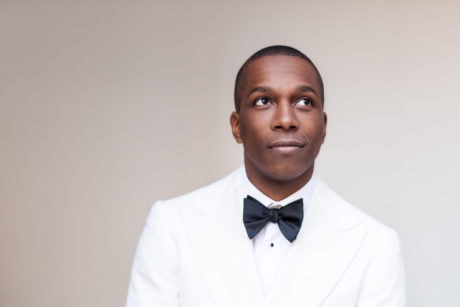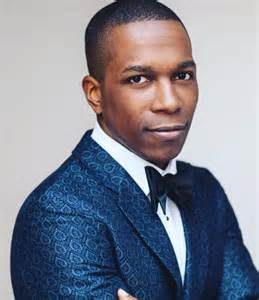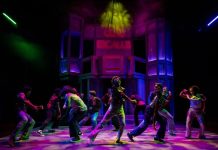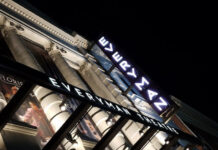You know him as Aaron Burr, Sir, the damned fool who shot Alexander Hamilton. Now get to know Leslie Odom, Jr., the man behind America’s most notorious villain. I spoke with Odom in advance of the 6th Annual An Evening of Unexpected Delights fundraiser benefiting The Journey Home at the Baltimore Lyric Opera House where he will perform with The Roots.

Odom, whose performance in Hamilton earned him the 2016 Tony Award for Best Actor in a Musical, released his self-titled debut album in June of 2016. It became the best-selling jazz album on Billboard and number one on the iTunes jazz chart.
If I had to pick one word to describe Leslie Odom, Jr. it would be “elegant.” The man oozes elegance. He first caught my attention for his performance as Sam Strickland, Christian Borle’s love interest on the TV series Smash. In one episode of Smash, Odom performs the song and dance number “Let’s Start Tomorrow Tonight” with vocals that hearken back to the crooners of yesteryear and the dance moves of Gene Kelly.
During his run in Hamilton, Odom was famous for his well-appointed interior-designed dressing room, complete with well-stocked bar to entertain well-wishers in comfort. He was unflaggingly patient and cordial with fans outside the Richard Rodgers Theatre stage door. Mr. Odom’s self-titled debut album continues his tradition of elegance and offers listeners insight into one of Broadway’s most remarkable performers.
Nicole: Leslie, thank you so much for taking the time to talk to me today and congratulations on your Tony Award! You are performing with the Roots as part of the 6th Annual An Evening of Unexpected Delights fundraiser at the Lyric Opera House in Baltimore. Why should people support this and what does this performance mean to you?
Leslie: I’m always thrilled when performing allows me to do more than just entertain. There is so much noise in the world today. So many people clamoring for attention and money. When I have a real opportunity to get involved in a good cause I jump at it. We were invited to come and make you forget that you are donating money to a great cause. I will be there for a half hour or 45 minutes to sing some songs from my record and from Hamilton and give you a great show.
Your self-titled debut album is a jazz album comprised of mostly standards from the American songbook. It is not hip-hop and not musical theater. What will fans learn about you from listening to this album?

I’m fine with that! However, music is where you can see me being myself. In my music I get to do exactly what I want, to sing exactly what I want and that has been a great outlet for me. Since leaving Hamilton, I’ve been performing to very enthusiastic and welcoming rooms around the country. We always leave a room smiling and excited that they came.
Your involvement in jazz music goes back pretty far, right?
Yes, I was a teenager when I started to take music seriously. It was late middle school when I started to get familiar with singers and musicians. Jazz was a natural fit for the voice God gave me and it was something that I ended up being interested in. Some of that stuff is just the way your voice is naturally made. There were some kids in school who were studying classical music but my voice wasn’t that. I discovered Ella (Fitzgerald) and Billie (Holiday) and Miles (Davis) and Nat King Cole and Frank Sinatra around those years and it set my feet on a path and gave my voice a direction for sure.
How do you approach recording standards? What are the challenges and thrills involved in finding a unique voice on songs that are part of the American musical lexicon? For example, I listened to the version of the 1956 Frank Loesser song “Joey, Joey, Joey,” from the musical The Most Happy Fella side by side with your version and, wow, what a difference. Your version is so much more soulful and full of longing. How do you approach creating something like that?
We always try to go back to the original lyric and the original melody, which in some cases is not always easy to find. We learn it the way it was written so that we are freed up from the recent versions we have heard. Sometimes you go back to the original melody and find that it is so beautiful and that no one has sung it like that for a long time. It’s so old it’s new! You could sing this thing exactly as it’s written and it would work. We always start there and then it’s just about clearing channels for exploration, getting everything else out of the way and doing what feels natural to me. That is something that I brought directly from my experience with Hamilton. I brought that attitude into the recording studio because that is what I was trying to do in Hamilton.
You recorded this album while you were still performing in Hamilton. What was that like?
Hamilton was a situation where songs were given to me that no one besides Lin (Lin-Manuel Miranda) had ever sung before. Lin had made a demo of “Wait for It,” but no other performer had ever recorded that song. No other performer had sung “The Room Where It Happens” or “Dear Theodosia.” You know, it takes a sure hand, it takes some confidence, it takes knowing who you are to put a stamp on something for the very first time, to be the first performer to do something. So, my work in the studio and on the stage complemented and informed each other for sure!
I noticed that in between all the standards like “Look for the Silver Lining” and “Autumn Leaves” there is one song from the early 21st Century rock musical Spring Awakening (“The Guilty Ones”), one Willy Nelson song (“The Party’s Over”) and one song sung in Portuguese (“Brasil”). And yet, with such diverse origins, the album has a really cohesive sound. What was your starting point and how did you get to this finished product?
So, in making this album, we went back and looked at the repertoires of the great crooners of our time and all time. When you look at what they sing you usually understand quickly why they sing it. It has to do with lyric and melody. If you are a person who has been trained to sing, who loves to push the limits of the human voice as an instrument then these songs are going to do that because their focus is really on melody and the story they are telling through the lyrics.
Singing is an oral tradition. It’s something that is passed down from singer to singer. There is a reason that there is a standard repertoire of songs. If you look at Nat King Cole’s rep (repertoire), and Frank Sinatra’s rep, they look a lot like Sammy Davis, Jr. or Michael Bublé or Harry Connick, Jr.’s rep. These songs strike a chord, but the definition of standards is malleable. It stretches as time goes on because someone like Lin-Manuel Miranda writes a song like “Wait for It” or “Dear Theodosia,” that has real staying power. Songs that, only time will tell, but in my opinion have a real chance to be around 100 years from now and be the standards, the oldies, the comfort music for kids then.
You won your Tony Award (for Best Actor in a Lead Role in a Musical) in a year when for the first time in history all four major acting awards were won by people of color. (In addition to Leslie Odom, Jr., Daveed Diggs and Renée Elise Goldsberry took home awards for Hamilton and Cynthia Erivo won for The Color Purple) What does it mean to you to be a part of that group?
You know, there is real power behind images. More people are going to see that picture than saw me in the show. Over time, way more people will see the picture of the four of us on that night, holding those awards, than will have seen the performances that we did for a year or a year and a half. I can just relate it to the power that image had on me as a young person. I wasn’t coming to NY to see shows. We didn’t have the money for that, we didn’t even go to the movies very often, but I saw these images of black people achieving great things and it couldn’t help but make me believe that I could achieve great things. I’m very proud to be a part of that moment that was captured in a picture. I’m very proud that I was one of those four faces with those artists that I know are going to continue to make us proud. Cynthia and Daveed and Renée! I’m so honored to even know them! I know that we are all just getting started so that picture will be a moment in time that was captured and we’ll all be able to look back on it, I hope, as just one of the things we’ve done to make you proud of us.
Hamilton caused a seismic shift in the world of musical theater. It brought hip-hop music into the theatrical sphere, it created amazing roles for people of color, and it had mass appeal beyond the traditional musical theater audience. In a way, Hamilton is about legacies. What do you think and hope the long-term legacy of Hamilton will be?

I think it’s going to be the legacy of common ground. Hamilton set a table for people to have conversations, including difficult conversations. When you have a person or a piece of art or a moment in time, like this election, for better or worse, that forces you to sit at a table and have hard conversations and realize that we are all in something together, it helps people find common ground. Hamilton has been so wide-reaching that it is sitting people at a table across from someone that they didn’t feel connected to a week ago or a year ago and they are connecting over Hamilton! That leads to conversation, friendships and relationships and that all leads to positive change.
One of the things I’ve gotten perspective on since leaving the show is seeing that Hamilton has been this force for families. There are not many things that people my age are connecting with their parents or their children over but that kind of inter-generational thing is happening over Hamilton. It starts conversations that lead to other things. I think Hamilton will leave many legacies but one of them will be for people to find connections. Like, we don’t agree on anything else, but we all loved Hamilton!
What has always struck a chord with me when hearing you talk about Aaron Burr is that you seem to have a great deal of compassion and empathy for the man. How did you come to that way of thinking about the man and the character?
Well, I think Lin started it! (laughs) Yeah, Lin started it. When you write a song like “Wait For It” or “Dear Theodosia,” for any performer who is paying attention, that writer is clearly telling you “I do not hate this person! I do not think this person should be written off.” Also, even if it is just for the purposes of storytelling, it doesn’t help the dramatization of the story if people are writing Aaron Burr off in the first twenty minutes of the show. So Lin started it and when I looked at what the man wrote and the empathy and compassion that he was showing Burr, it became my blueprint and told me which way I should walk, which path I should take and so I just continued from where he started.
Have you seen Brandon Victor Dixon (NYC) or Joshua Henry (Chicago) in Hamilton yet?
I haven’t yet, but I can’t wait! I’m sure I’ll get there. Josh is still in previews and Brandon has only been going since August so I’ll give them time.
If you could dream cast for the Hamilton movie, who would you cast as Aaron Burr (if not yourself)?

It depends on when they make it. If they are making the thing fifteen years from now, as much as I would like to see Mos Def in the part, he might be a little long in the tooth. I would just like to see somebody that was going to do the part justice and do Lin’s music justice and could also really take on the challenge that Lin put forth to us to open our hearts to this material and approach it with empathy and go as far as we could go with it.
What is next for you? And how are you adjusting to life post-Hamilton? You’ve been out for three months now.
I have a Christmas album coming out on November 11th. I’m also in talks to shoot a film soon. Basically, I’m just looking to grow. I’m walking towards things that are challenging. It doesn’t mean my next project is going to be as successful as Hamilton or as popular. It’s not about that but it has to be a place where somebody wants me to continue where I left off. I don’t want to go backwards, that’s all.
What can listeners expect to hear from you at The Journey Home Benefit at the Lyric Opera house on Saturday, October 22nd?
Some stuff from the album, some stuff from Hamilton. We are there for a great cause but our goal is to get you to forget about the cause, enjoy the music, and leave with a smile on your face.
Leslie Odom, Jr. will perform on Saturday, October 22, 2016, with The Roots at the Lyric Opera House – 140 West Mount Royal Avenue, in Baltimore, MD – as part of the 6th Annual An Evening of Unexpected Delights Fundraiser to benefit The Journey Home, Baltimore City’s plan to decrease homelessness. For tickets, call the box office at (410) 900-1150, or purchase them online.





